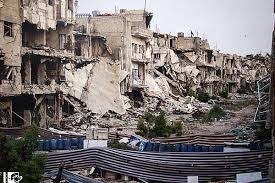Whenever the opposition forces approach a major sectarian area, or fight within one, the official state media starts producing messages, broadcasting invented massacres and mass graves they claim to be the work of the armed opposition.
It happened when the clashes took place in Sadad and Maloula, which are mainly inhabited by Christians and in Mogher al-Meer and Kefteen, which are inhabited by Druze. Such cases, and what has been propagated as massacres committed by the opposition forces– which were later found not to have happened—leaves no doubt about the role of the regime in promoting propaganda in order to feed sectarianism, fuel the sectarian structures, and push those forces toward greater involvement in the war to suppress the revolution. While the initial effect of news about terrible massacres such as these cannot be easily struck from people’s minds, the voice of the official media fades with the emergence of eye-witnesses from the areas, disillusioned with the regime’s false accounts. The official state media loses more viewers who had previously considered it a useful information source for them.
Several days ago in Maloula, the famous and historic town, the terrified residents explained what happened. The group who attacked the town was not targeting civilians as reported by one person—who preferred to keep his identity unknown—but rather, the attackers had been targeting a Syrian military checkpoint and military station located in the town. The people were killed in Maloula because they had attacked the fighters who were entering the town. Furthermore, the people knew for certain that what was stolen from their homes was taken by the shabiha who had supposedly arrived to rescue the town. Does this mean that the attackers were angels, who commit no mistakes or transgressions? On the contrary, the fighters’ chaos that had permeated all areas of the town had provoked the people and compelled them to react, but the fighters did not commit massacres against civilians or rob their homes as the official media purportedly showed in photos.
Until today, the people of Mogher al-Meer, located in Kenitra and inhabited mainly by Druze, had not returned to their village near the border with Israel since the widespread clashes killed ten people from the village. It had been a peaceful village avoiding the conflict, and its people preferred to remain neutral. But the security services interfered to arm the people and push them into conflict with the nearby villagers who had joined the Free Syrian Army (FSA).
Indeed, the sectarian conflict is the ideal model allowing the regime to continue. In the first clashes between those villages five months ago, one woman and a young man were killed during the FSA’s attack on a military barracks located near the town. The FSA advanced into the village itself, which caused the Baathists to arm a few of the shabiha there and pit them against the FSA battalions, which numbered several thousand fighters. So right from the beginning, the newly armed men faced uneven odds. The fighting claimed the lives of seven of them, and turned the village into a ghost town. As usual, the flocks of shabiha went into the village and looted the houses before coming under siege for hours by the opposition forces in the village. The regular [government] army did not intercede to rescue them, instead leaving them to meet their fate despite the repeated SOS calls sent from the shabiha’s mobile phones, begging the regular army to intervene and rescue them. Is there a bigger trap than this?
It is not courageous to attack peaceful towns like Maloula, Sadad, or Mogher al-Meer, although it was easy to do. But when the opposition forces do attack, they certainly do not do it because they are areas inhabited by minority religious groups, but rather because the regime tried to ignite into a flashpoint was a way to get at the rebel perimeter. When the clashes occurred, the official media declared it to be sectarian war and, without qualms, it encouraged—baited— young men from the minority areas and put them in the face of the same well-trained armed forces that have proved, for more than two and a half years, to be the regime’s equal. The rebels have even achieved great victories in many areas.
From the outbreak of the revolution to today, the regime has not spared any effort to inflame the feelings of ethnic minorities and push them into aggression against the rebels. Assad is slowly becoming convinced that he will not succeed, so he is resorting to using to foreign sectarian groups, such as the Abu al-Fadl al-Abbas Brigade, the Hassan Mujtaba Brigade, and Hezbollah’s mercenaries, using them—whatever their religious sect or affiliation—as pawns in his battle against the sons of the Syrian people.
......


